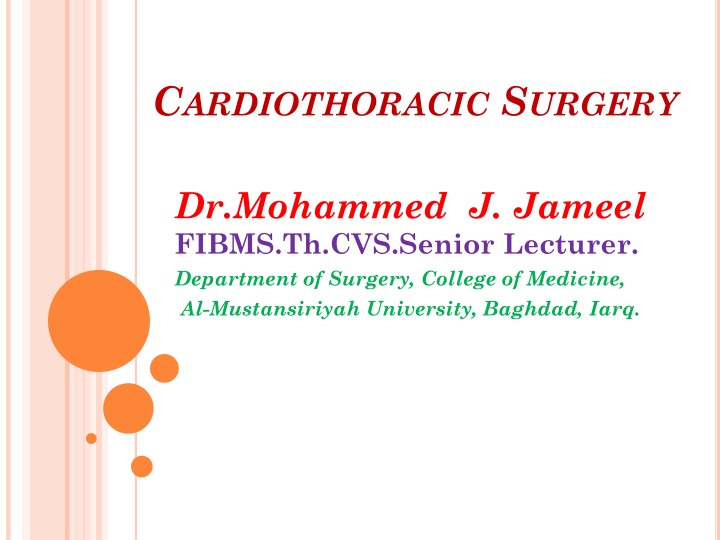
Understanding Thoracic Injuries and Immediate Life-Threatening Situations in Cardiothoracic Surgery
Explore the management of thoracic injuries and immediate life-threatening conditions in cardiothoracic surgery, including airway obstruction, cardiac tamponade, tension pneumothorax, open pneumothorax, and massive hemothorax. Learn about their etiology, clinical features, diagnostic considerations, and crucial treatment interventions.
Download Presentation

Please find below an Image/Link to download the presentation.
The content on the website is provided AS IS for your information and personal use only. It may not be sold, licensed, or shared on other websites without obtaining consent from the author. If you encounter any issues during the download, it is possible that the publisher has removed the file from their server.
You are allowed to download the files provided on this website for personal or commercial use, subject to the condition that they are used lawfully. All files are the property of their respective owners.
The content on the website is provided AS IS for your information and personal use only. It may not be sold, licensed, or shared on other websites without obtaining consent from the author.
E N D
Presentation Transcript
CARDIOTHORACIC SURGERY Dr.Mohammed J. Jameel FIBMS.Th.CVS.Senior Lecturer. Department of Surgery, College of Medicine, Al-Mustansiriyah University, Baghdad, Iarq.
LCE : 9 Thoracic Injuries :- Account for 25% of all injuries, usually they life-threatening and occur due to bleeding but fourtunately 80% can be manged conservatively by proper Dx and resuscitation. Immediate Life Threatening Injuries :- 1. Air Way Obstruction :- Early preventable trauma deaths are usually dueto lack of or delay in air way control. Air way obstruction in trauma usuallycaused by :- 1. Dentures , teeth , secreation and blood 2.Bilateral mandibular fracture. 3. expanding neck hematoma cause compression and deviation of trachea. 4.Laryngeal or Tracheal injuries. Mx :- Early endotracheal intubationis important especially in case of neck hematoma or air-way edema with protection of cervical spine if their injury is suspected to prevent damage to cervical cord. 2. Cardiac Temponade :- Lec 4
3. Tension Pneumothorax :- develops when a one-way valve air leak occurs either from the lung or through the chest wall , air is forced into the thoracic cavity without any mean of escape, completely collapsing the affected lung, the Mediastinum is displaced to the opposite side , decreasing the venous return and compressing the opposite lung. Etiology :- 1. Penterating chest trauma parenchymal lung injury and air leak that did not close spontenously 3. Iatrogenic lung puncture e.g from Subclavian central venous insertion. 4. mechanical positive pressure ventilation. C.F :- 1. The Pt. is panicky with dypnea , tachypnea and distended neck veins with cyanosis. O/E :- tracheal deviation , hyperresonant and absent breath sounds over the affected hemithorax Tension Pneumothorax is a clinical Dx. And Rx must not be delayed waiting for Radiological confirmation. Rx :- 1. Rapid insertion of large bore needle into 2ndintercostal space in the Mid-clavicular line of the affected hemithorax. 2. insertion of chest tube through 5thICS between anterior and mid axillary line and direct it to apex of hemithorax. 2. Blunt chest trauma with
4. Open Pneumothorax :- is due to large defect in the chest wall > 3 cm leading to equilibration between intrathoracic and atmospheric pressure , air accumulate in hemithorax with each inspiration leading to profound hypoventilation on the affected side and hypoxia. Mx :- 1. close the defect with a sterile occlusive plastic dressing taped on three sides act as a flatter-type valve. 2. a large bore chest tube is inserted in a site away from the site of injury , if the lung doesnot expand the drain must be connected to low pressure suction , a2nd drain is sometimes necessary 3. debridement and closure of chest wall defect usually done in the operative room. 5. Massive Heamothorax :- in blunt trauma is caused by continous bleeding from torn intercostal or internal mammary artery. Accumulation of blood in the hemithorax compress the lung and prevent adequate ventilation. C.Fs :- pt. present with signs of heamorrhagic shock (tachycardia and hypotension) with flat neck veins , unilateral absence of breath sounds and dullness to percussion.
Rx :- 1. insertion of chest tube to remove the blood completely 2. correct hypovolemic state by using central venous line and replacement by crystalloid and colloids , sometimes Endotracheal intubation may be necessary. 3. initial drain > 1500ml or continous bleeding > 200ml /hr.for 3 hr.s indicates urgent Thoracotomy 6. Flial chest :- usually result from blunt trauma when 3 or more ribs fractured at 2 or more places producing a loose segment of chest wall moves paradoxically with respiration i.e moves inwards during inspiration this together with lung contusion and pain result in hypoxia , a heamo and /or pneumothorax may be associated. Mx 1. Oxygen administration and physiotherapy 3. chest tube insertion when necessary. 2. Adequate analgesia
Potenially Life Threatening injuries :- 1. Thoracic Aortic disruption :- common cause of sudden death after Blunt trauma e.g automobile collision or fall from height ,with deceleration the aortic arch moves anteriorly while the descending aorta is relatively fixed distal to ligamentum arteriosum just distal to origin of subclavian A. this will produce a shearing forces from the sudden impact will disrupt the intima and media, if the adventetia is intact the Pt. may remain stable but require Urgent Rx. Dx :- Pt. with blunt chest trauma + Asymmetry of upper and Lower limb Pressure + widen Pulse pressure , We must suspect the injury , CXR in erect position shows Widen Mediastinum Dx is confirmed by Arch Aortography OR CT angiography Mx :- 1. control systolic BP < 100 mm Hg. 2. Use of Endovascular intra-Aortic Stent can be placed or by surgery either repair OR Excision and grafting using a Dacron graft. Traumatic aortic rupture is
2. Tracheobronchial injuries :- Pt. present with severe subcutaneous emphysema withrespiratory compromise , chest tube shows massive air leak and lung fail to expand , Bronchoscopy is diagnostic Rx :- ETI of unaffected side followed by operative repair of the injury. 3. Blunt Myocardial injury :- 4. Diaphragmatic injury :- any penetrating injury below 5th ICS suspect it and Dxic Laproscope m.b required. Blunt chest trauma can cause diaphragm rupture which may be missed , it occurs mostly on left side. Dx :- CXR after placement of Nasogastric tube can show the stomach herniated to chest Rx :- Diaphragm rupture when Dxed Acutely must be repaired through laprotomy this will help toexamin abdominal structures to exclude injury , but when Dx is missed initially and injury discovered later it must be repaired by thoracotomy.
5. Esophageal injury :- mostly caused by penetrating trauma , it must be kept in mind , Pt. presnt with odynophagia (pain on swallowing of food or fluids ) , subcutaneous or mediastinal emphysema, pleural effusion, air in retroesophageal space and unexplained fever with in 24 hours of onset of injury. Dx:- Esophagogram in supine position + Esophagoscopy Rx :- Operative repair and drainage. 6. Pulmonary contusion :- caused by bleeding into lung parenchyma secondary to blunt trauma , Pt. present with hypoxemia with in 24 48 hours of injury , sometimes with hemoptasis. Dx by CXR which shows opacified lung. Rx O2 adminstration + analgesia + chest physiotherapy , in severe casesmechanical ventilation is required.






















